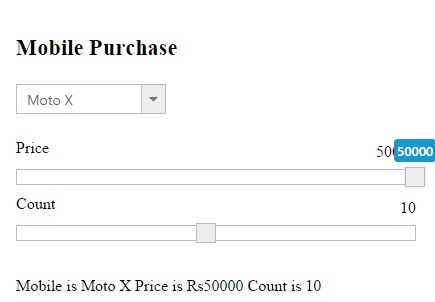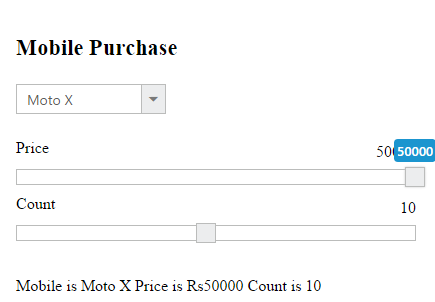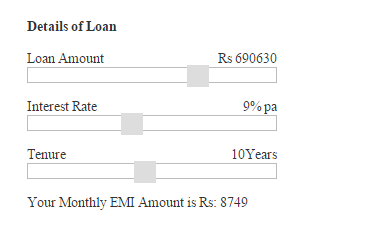- Create a Slider
- Create EMI Calculator
Contact Support
Getting Started
17 Aug 201724 minutes to read
This section explains briefly about how to create a Slider in your application with JavaScript.
Essential JavaScript Slider widget provides support to display a Slider within the web page. Here, you can learn how to use Sliders in a real-time application. The example shows you how to use the Slider control to select mobile model within the specified price range in a Mobile Purchase Application.
The following screenshot demonstrates the functionality of Slider control. By selecting mobile model in the dropdown, you can purchase a mobile at any rate specified in the Mobile Price Slider. In addition, you can also specify the number of mobiles you require by using the Mobile Count Slider. Simultaneously, you can observe the changes in the Mobile Price and Count using Sliders.

Create a Slider
Essential JavaScript Slider widget allows you to switch between different ranges of input. The basic Slider is in horizontal position and has a single handle that is moved by the mouse or the arrow keys.
Create an HTML file and add the following template to the HTML file.
<!DOCTYPE html>
<html>
<head>
<meta name="viewport" content="width=device-width, initial-scale=1.0" charset="utf-8" />
<!-- Style sheet for default theme (flat azure) -->
<link href="http://cdn.syncfusion.com/28.1.33/js/web/flat-azure/ej.web.all.min.css" rel="stylesheet"/>
<!--Scripts-->
<script src="http://cdn.syncfusion.com/js/assets/external/jquery-1.10.2.min.js"></script>
<script src="http://cdn.syncfusion.com/28.1.33/js/web/ej.web.all.min.js"></script>
<!--Add custom scripts here -->
</head>
<body>
<!-- add Mobile Purshase element element here -->
</body>
</html>Add input element to render a Slider.
<div class="content-container-fluid">
<div class="row">
<div class="cols-sample-area">
<div class="frame">
<div id="priceheading">
<h3>Mobile Purchase</h3>
<input type="text" id="selectMobile" />
<div id="mobileList">
<ul>
<li>Moto X</li>
<li>Moto g</li>
<li>Nexus</li>
<li>Xperia</li>
<li>Samsung</li>
</ul>
</div>
</div>
<span class="column-left">
<span class="price">Price</span>
</span>
<span class="column-right">
<span id="priceText"> </span>
<span class="value"></span>
</span>
<div id="priceSlider">
</div>
<span class="column-left">
<span class="price">Count</span>
</span>
<span class="column-right">
<span id="counttext"></span><span class="value"></span>
</span>
<div id="countSlider">
</div>
<div id="EventLog"></div>
</div>
</div>
</div>
</div>Add the following styles to show the Mobile Rate Slider widget in horizontal order.
<style type="text/css" class="cssStyles">
.frame {
width: 230px;
padding: 50px;
}
.price, .count {
margin-top: 5px;
font-weight: 400;
}
.value, #priceText, #counttext {
float: right;
position: relative;
width: auto;
padding-left: 3px;
}
#priceText, #counttext {
width: auto;
}
#result {
margin-top: 25px;
text-align: center;
font-weight: 600;
}
.frame .e-slider-wrap {
display: block;
margin-top: 40px;
}
.column-left {
width: 35%;
float: left;
font-weight: 400;
margin-top: 10px;
}
.column-right {
width: 65%;
float: right;
font-weight: 600;
margin-top: 14px;
}
#priceheading {
font-family: 'Arial Black', Gadget, sans-serif;
font-size: larger;
padding-bottom: 15px;
}
</style>Initialize Slider using the following code example.
var priceObj, countObj, priceValue = 0,target;
$(function() {
$('#selectMobile').ejDropDownList({
targetID: "mobileList",
width: "150px"
});
var priceValue = 25,
interestValue = 4,
priceValue = 1;
$("#priceSlider").ejSlider({
height: 16,
value: priceValue,
minValue: 10000,
maxValue: 50000,
incrementStep: 1,
change: "onChange",
slide: "onChange"
});
$("#countSlider").ejSlider({
height: 16,
value: priceValue,
minValue: 1,
maxValue: 20,
incrementStep: 1,
change: "onChange",
slide: "onChange"
});
mobObj = $("#selectMobile").data('ejDropDownList');
priceObj = $('#priceSlider').data('ejSlider');
countObj = $('#countSlider').data('ejSlider');
calculate();
});
function onChange(args) {
this.wrapper.prev().children('span.value').html(args.value);
calculate();
}
function calculate() {
var price = priceObj.getValue();
var mob = mobObj.getValue();
var count = countObj.getValue();
$('#EventLog').html("Mobile is " + mob + " Price is Rs" + price + " Count is " + count);
}The following screenshot displays a Mobile Purchase using Slider.

Create EMI Calculator
Based on the loan amount, interest rate and tenure, you can calculate EMI amount using Slider.
Add input element to render a Slider.
<div class="content-container-fluid">
<div class="row">
<div class="cols-sample-area">
<div class="frame">
<div id="loanheading">
Details of Loan
</div>
<span class="column-left">
<span class="loan">Loan Amount</span>
</span>
<span class="column-right">
<span class="value"></span><span id="loanText">Rs </span>
</span>
<div id="loanSlider">
</div>
<span class="column-left">
<span class="interest">Interest Rate</span>
</span>
<span class="column-right">
<span id="interestText">% pa</span><span class="value"></span>
</span>
<div id="interestSlider">
</div>
<span class="column-left">
<span class="tenure">Tenure</span>
</span>
<span class="column-right">
<span id="tenuretext">Years</span><span class="value"></span>
</span>
<div id="tenureSlider">
</div>
<div id="result">
Your Monthly EMI Amount is
<span id="EventLog"></span>
</div>
</div>
</div>
</div>
</div>Add the following styles to show the EMI Calculation Slider widget in horizontal order.
<style type="text/css" class="cssStyles">
.frame {
width: 400px;
}
.loan, .interest, .tenure {
margin-top: 5px;
font-weight: 400;
}
.value, #loanText, #interestText, #tenuretext {
float: right;
position: relative;
width: auto;
padding-left: 3px;
}
#loanText, #interestText, #tenuretext {
width: auto;
}
#result {
margin-top: 25px;
text-align: center;
font-weight: 600;
}
.frame .e-slider-wrap {
display: block;
margin-top: 40px;
}
.column-left {
width: 35%;
float: left;
font-weight: 400;
margin-top: 10px;
}
.column-right {
width: 65%;
float: right;
font-weight: 600;
margin-top: 14px;
}
#loanheading {
font-family: 'Arial Black', Gadget, sans-serif;
font-size: larger;
padding-bottom: 15px;
}
</style>Initialize Slider using the following code example.
var loanObj, interestObj, tenureObj, loanValue = 0,
interestValue = 0,
tenureValue = 0;
$(function() {
var loanValue = 25000,
interestValue = 4,
tenureValue = 3;
$("#loanSlider").ejSlider({
height: 16,
value: loanValue,
minValue: 10000,
maxValue: 1000000,
incrementStep: 10,
change: "onChange",
slide: "onChange"
});
$("#interestSlider").ejSlider({
height: 16,
value: interestValue,
minValue: 1,
maxValue: 20,
incrementStep: 1,
change: "onChange",
slide: "onChange"
});
$("#tenureSlider").ejSlider({
height: 16,
value: tenureValue,
minValue: 1,
maxValue: 20,
incrementStep: 1,
change: "onChange",
slide: "onChange"
});
loanObj = $('#loanSlider').data('ejSlider');
interestObj = $('#interestSlider').data('ejSlider');
tenureObj = $('#tenureSlider').data('ejSlider');
calculate();
});
function onChange(args) {
this.wrapper.prev().children('span.value').html(args.value);
calculate();
}
function calculate() {
var loan = loanObj.getValue(),
interest = interestObj.getValue(),
tenure = tenureObj.getValue();
var P = loan;
var y = interest / 1200;
var tenureAmount = tenure * 12;
//actual processing
var top = y * (Math.pow((1 + y), tenureAmount));
var bottom = (Math.pow((1 + y), tenureAmount)) - 1;
var ans = top / bottom;
var final = P * ans;
var z = Math.round(final);
$('#EventLog').html("Rs: " + z);
}The following screenshot displays a EMI Calculation application using Slider.
